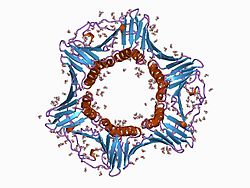Function
CDK inhibition
p21 is a potent cyclin-dependent kinase inhibitor (CKI). The p21 (CIP1/WAF1) protein binds to and inhibits the activity of cyclin-CDK2, -CDK1, and -CDK4 /6 complexes, and thus functions as a regulator of cell cycle progression at G1 and S phase. [12] [13] The binding of p21 to CDK complexes occurs through p21's N-terminal domain, which is homologous to the other CIP/KIP CDK inhibitors p27 and p57. [6] Specifically it contains a Cy1 motif in the N-terminal half, and weaker Cy2 motif in the C-terminal domain that allow it to bind CDK in a region that blocks its ability to complex with cyclins and thus prevent CDK activation. [14]
Experiments looking at CDK2 activity within single cells have also shown p21 to be responsible for a bifurcation in CDK2 activity following mitosis, cells with high p21 enter a G0/quiescent state, whilst those with low p21 continue to proliferate. [15] Follow up work, found evidence that this bistability is underpinned by double negative feedback between p21 and CDK2, where CDK2 inhibits p21 activity via ubiquitin ligase activity. [16]
PCNA inhibition
p21 interacts with proliferating cell nuclear antigen (PCNA), a DNA polymerase accessory factor, and plays a regulatory role in S phase DNA replication and DNA damage repair. [17] [18] [19] Specifically, p21 has a high affinity for the PIP-box binding region on PCNA, [20] binding of p21 to this region is proposed to block the binding of processivity factors necessary for PCNA dependent S-phase DNA synthesis, but not PCNA dependent nucleotide excision repair (NER). [21] As such, p21 acts as an effective inhibitor of S-phase DNA synthesis though permits NER, leading to the proposal that p21 acts to preferentially select polymerase processivity factors depending on the context of DNA synthesis. [22]
Apoptosis inhibition
This protein was reported to be specifically cleaved by CASP3-like caspases, which thus leads to a dramatic activation of CDK2, and may be instrumental in the execution of apoptosis following caspase activation. However p21 may inhibit apoptosis and does not induce cell death on its own. [23] The ability of p21 to inhibit apoptosis in response to replication fork stress has also been reported. [24]
Regulation
p53 dependent response
Studies of p53 dependent cell cycle arrest in response to DNA damage identified p21 as the primary mediator of downstream cell cycle arrest. Notably, El-Deiry et al. identified a protein p21 (WAF1) which was present in cells expressing wild type p53 but not those with mutant p53, moreover constitutive expression of p21 led to cell cycle arrest in a number of cell types. [25] Dulcic et al. also found that γ-irradiation of fibroblasts induced a p53 and p21 dependent cell cycle arrest, here p21 was found bound to inactive cyclin E/CDK2 complexes. [26] Working in mouse models, it was also shown that whilst mice lacking p21 were healthy, spontaneous tumours developed and G1 checkpoint control was compromised in cells derived from these mice. [27] [13] Taken together, these studies thus defined p21 as the primary mediator of p53-dependent cell cycle arrest in response to DNA damage.
Recent work exploring p21 activation in response to DNA damage at a single-cell level have demonstrated that pulsatile p53 activity leads to subsequent pulses of p21, and that the strength of p21 activation is cell cycle phase dependent. [28] Moreover, studies of p21-levels in populations of cycling cells, not exposed to DNA damaging agents, have shown that DNA damage occurring in mother cell S-phase can induce p21 accumulation over both mother G2 and daughter G1 phases which subsequently induces cell cycle arrest; [29] this responsible for the bifurcation in CDK2 activity observed in Spencer et al.. [15]
Degradation
p21 is negatively regulated by ubiquitin ligases both over the course of the cell cycle and in response to DNA damage. Specifically, over the G1/S transition it has been demonstrated that the E3 ubiquitin ligase complex SCF Skp2 induces degradation of p21. [30] [31] Studies have also demonstrated that the E3 ubiquitin ligase complex CRL4 Cdt2 degrades p21 in a PCNA dependent manner over S-phase, necessary to prevent p21 dependent re-replication, [32] as well as in response to UV irradiation. [33] Recent work has now found that in human cell lines SCFSkp2 degrades p21 towards the end of G1 phase, allowing cells to exit a quiescent state, whilst CRL4Cdt2 acts to degrade p21 at a much higher rate than SCFSkp2 over the G1/S transition and subsequently maintain low levels of p21 throughout S-phase. [29]
Clinical significance
Cytoplasmic p21 expression can be significantly correlated with lymph node metastasis, distant metastases, advanced TNM stage (a classification of cancer staging that stands for: tumor size, describing nearby lymph nodes, and distant metastasis), depth of invasion and OS (overall survival rate). A study on immunohistochemical markers in malignant thymic epithelial tumors shows that p21 expression has a negatively influenced survival and significantly correlated with WHO (World Health Organization) type B2/B3. When combined with low p27 and high p53, DFS (Disease-Free Survival) decreases. [34]
p21 mediates the resistance of hematopoietic cells to an infection with HIV [35] by complexing with the HIV integrase and thereby aborting chromosomal integration of the provirus. HIV infected individuals who naturally suppress viral replication have elevated levels of p21 and its associated mRNA. p21 expression affects at least two stages in the HIV life cycle inside CD4 T cells, significantly limiting production of new viruses. [36]
Metastatic canine mammary tumors display increased levels of p21 in the primary tumors but also in their metastases, despite increased cell proliferation. [37] [38]
Mice that lack the p21 gene gain the ability to regenerate lost appendages. [39]
This page is based on this
Wikipedia article Text is available under the
CC BY-SA 4.0 license; additional terms may apply.
Images, videos and audio are available under their respective licenses.





